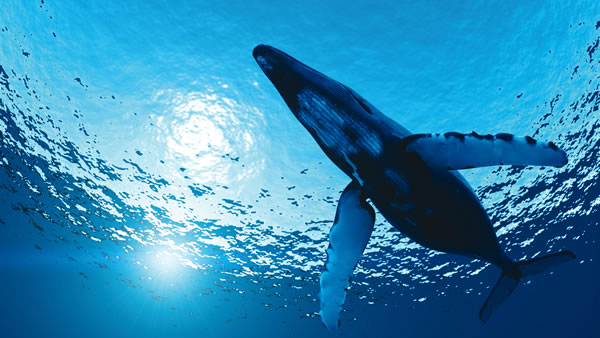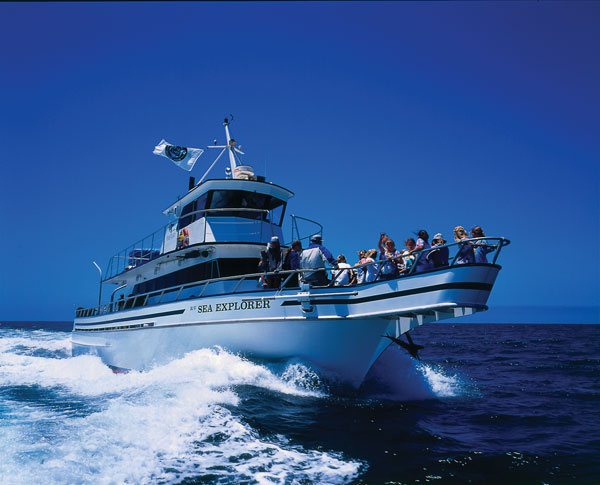Whales
One of the sea’s largest mammals—the blue whale—is appearing along coastal Orange County in numbers and in varieties not seen before.- By John Grafman

 From the moon to the marine, few things seem unexplainable to scientists and researchers, but one maritime mystery has ocean experts stumped.“Blue whales are still a bit of a mystery, as so much of their lives are spent midocean and far from the view of man, unlike many other near-coastal whales and dolphins,” says Mike Bursk, captain of the Ocean Institute’s research vessel Sea Explorer.Bursk, who works with the Ocean Institute in Dana Point, Calif., further explains that the best window for study is during the summer months, when thousands of North Pacific blues converge in the coastal waters of Southern California, ranging roughly from Monterey to the Mexican border. Here, they gorge on swarms of small, shrimp-like zooplankton nicknamed “krill.”For unknown reasons, Southern California waters have been far richer in krill the last decade than in years past, and the blues have responded by taking up residence from July through at least October, feeding in waters only 600 to 1,000 feet deep, and often within sight of shore. “No one can guess why this trend started or how long it will last,” Bursk says.
From the moon to the marine, few things seem unexplainable to scientists and researchers, but one maritime mystery has ocean experts stumped.“Blue whales are still a bit of a mystery, as so much of their lives are spent midocean and far from the view of man, unlike many other near-coastal whales and dolphins,” says Mike Bursk, captain of the Ocean Institute’s research vessel Sea Explorer.Bursk, who works with the Ocean Institute in Dana Point, Calif., further explains that the best window for study is during the summer months, when thousands of North Pacific blues converge in the coastal waters of Southern California, ranging roughly from Monterey to the Mexican border. Here, they gorge on swarms of small, shrimp-like zooplankton nicknamed “krill.”For unknown reasons, Southern California waters have been far richer in krill the last decade than in years past, and the blues have responded by taking up residence from July through at least October, feeding in waters only 600 to 1,000 feet deep, and often within sight of shore. “No one can guess why this trend started or how long it will last,” Bursk says.
Indeed, the prospering krill are in part one of the reasons we see more baleen whales, such as blues, humpbacks and grays; however, this really doesn’t justify the increasing number of orcas sightings off of California in 2012.
Overall, it would seem that the whale population is looking rather robust based on the recent accounts. But as Paul Watson, founder of the Sea Shepherd Conservation Society and star on Animal Planet’s “Whale Wars,” points out, “The fact that you are seeing more whales doesn’t necessarily mean that more whales exist. In addition, sometimes people observe more animals because of slight variations in migration routes that may be due to all sorts of things, including climate change, abundance of food sources and current streams.”
Coastal Sights
Dan Stetson, president and CEO of the Ocean Institute in Dana Point, Calif., also affirms this claim. “Twenty years ago when I started at the Ocean Institute, we were not seeing any blue whales off our Orange County coastline,” he says. “Now, over the past few years we are seeing them in large numbers and great regularity. In fact, our coastline is probably the best place in the world to see these magnificent creatures.”
Watson, a lifelong, outspoken activist, also believes that residents and visitors to coastal Orange County will see more whales due to established migration routes. With changing shipping routes and continued habitat destruction, however, it’s hard to project the long-term effects on migration patterns.
“The number of blue whale strikes on the West Coast this year has increased four-fold—a growing and very alarming problem,” Watson says. “Blue whale populations are extremely low, and researchers still know little about their behavior.”
The coastal fishing industry faced a daunting setback in 2010 to 2011 caused by a colder-than-normal current, which dramatically impacted summer fishing of tuna and other pelagic fish. Coupled with this lackluster fishing are spikes in fuel prices that are being passed along to fishermen. The result is a noticeable reduction in fishermen paying to go on sportboats. As a strange twist of fate, the fishing fleet has been able to hold its own by serving double-duty providing whale-watching tours. The upsurge in whale activity couldn’t have happened at a better time.
Whale Respect
There are numerous responsible commercial whale-watching tours, but Watson advises for a less intrusive way to get a glimpse of these rarely seen creatures.
“Whale watching is a double-edged sword. On one hand, people have found a way to connect with these majestic creatures; on the other hand, in their attempt to have an unforgettable experience, many people might feel they need to be as close as possible to be connected to the animal,” Watson says. “This is not in the best interest of the whales. Just our noise in the vicinity causes disruptions in their behavior. If one does go whale watching, he or she should keep in mind it’s about observing and respecting the animal in its natural world.”
Internationally, a ban on the commercial whaling of blue whales came into effect in 1966 under the International Convention for the Regulation of Whaling. Under the U.S. Endangered Species Act of 1973 blues are still considered endangered. Violations of the Marine Mammal Protection Act and/or the Endangered Species Act may result in civil or criminal penalties (up to $50,000).
Additionally, harassing or stressing whales and failure to abide by the federal regulations can lead to jail time. The law provides very distinct directives as the vessel approaches a whale. It is illegal to approach within 100 feet of whales.
“Remember that these are just legal guidelines that provide minimum safety for people and for whales,” Watson says. He advises to use common sense, yield to the whales and give them lots of space to pursue their natural interests. Watson also says people should always remain respectful of marine animals, and remember we are guests in their habitat.
“The question becomes what can we do as individuals to help save the whales and our oceans?” Watson continues. “The strength of an eco-system lies in diversity. The strength of any movement also lies in diversity in ideas, strategy, tactics and imagination. The approach can be educational, litigious, legislative, civil disobedience, protest or interventionist. People simply need to harness their own skills and passions to an issue and champion it.”
And with more of these big blues gliding nearby the coasts of Orange County, it seems that people will have to start paying more attention to these creatures and their environment.
Hopefully, with delicate attention and care to the ocean, these endangered animals will continue to make their enjoyable visit each year a regular one for generations to come.









